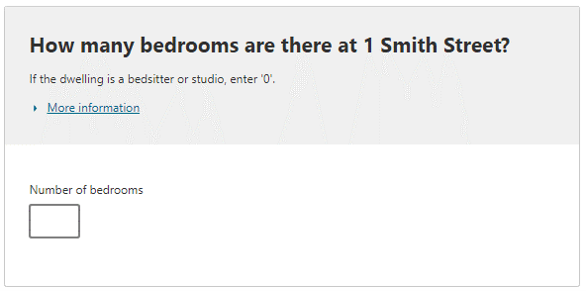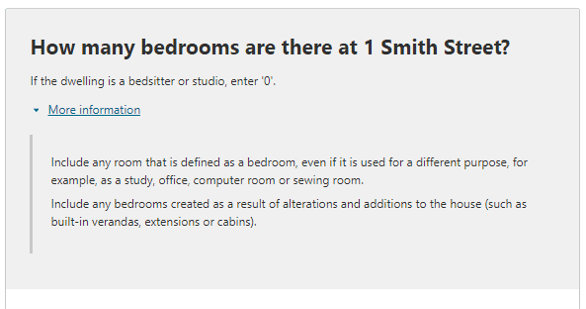Image

Description
More information
Image

This variable records the count of bedrooms in each occupied private dwelling. A private dwelling is defined in Dwelling structure (STRD) and can include caravans in caravan parks, occupied tents, and houseboats.
This variable is available as a single Count of all bedrooms (BEDD) and in ranges (BEDRD).
In standard Census products (Quickstats, Community Profiles), number of bedrooms data are generally published in the range categories for BEDRD.
Occupied private dwellings
| Code | Category |
|---|---|
| 00 | None (includes studio apartments or bedsitters) |
| 01-29 | 1 to 29 bedrooms singly |
| 30 | 30 or more bedrooms |
| && | Not stated |
| @@ | Not applicable |
Number of categories: 33
Not applicable (@@) category comprises:
This variable is created based on responses given for the Number of bedrooms question on the Census form. The responses are captured automatically from written numeric responses, or from the 'None' mark box on the paper form.
Number of bedrooms in private dwelling codes numeric responses from 0 to 29 bedrooms as reported and responses of 30 or more bedrooms are coded into the grouped category '30 or more bedrooms'.
A question on the number of rooms/bedrooms has been included in every Australian Census since 1911. However, the question relating to number of bedrooms in a private dwelling was first asked in the 1976 Census.
The 1986 Census form asked householders to indicate the numbers of various room types within the dwelling. Only the number of bedrooms was retained in the computer record. The 1991 and 1996 censuses collected data on the number of bedrooms only.
Since the 2001 Census, respondents have been asked to write in the number of bedrooms in their dwelling rather than mark a response category. An additional 'None' mark box was added to the paper form in 2006.
In 2021, the category has been reworded from ‘None (includes bedsitters)’ to ‘None (includes studio apartments or bedsitters)’.
Number of bedrooms data is commonly used to provide an indication of:
When calculating occupancy ratios, it is preferable to use the number of people usually resident in the home, rather than the number of people present in the household on Census Night. This data can be used with Dwelling structure (STRD) and Dwelling location (DLOD) to provide more context to the number of bedrooms.
The data may include a small proportion of dwellings with unusually high number of bedrooms, as all numeric responses are accepted as reported.
The non-response rate for Number of bedrooms in private dwelling (BEDD) was 5.4% in 2021. This is a decrease from 7.4% in 2016.